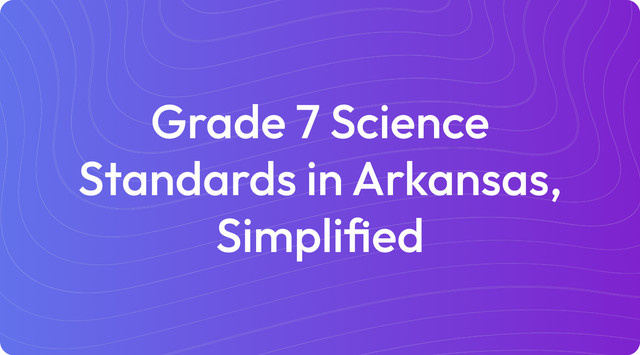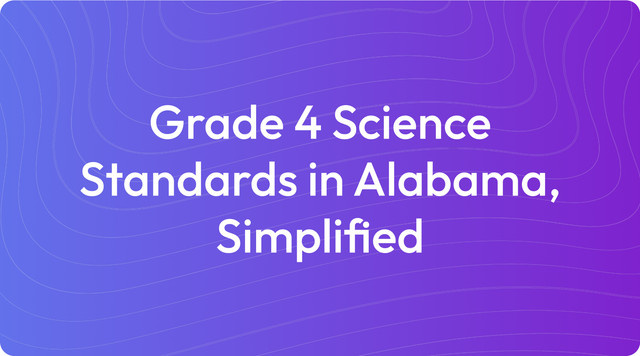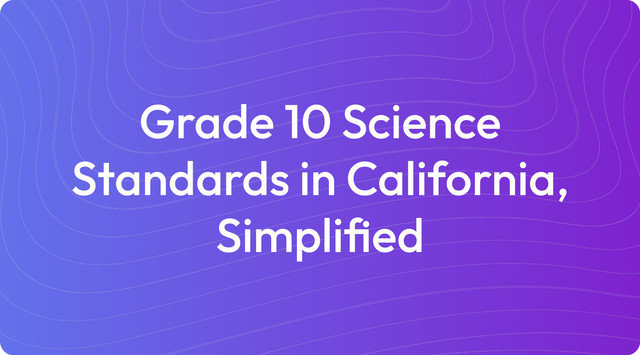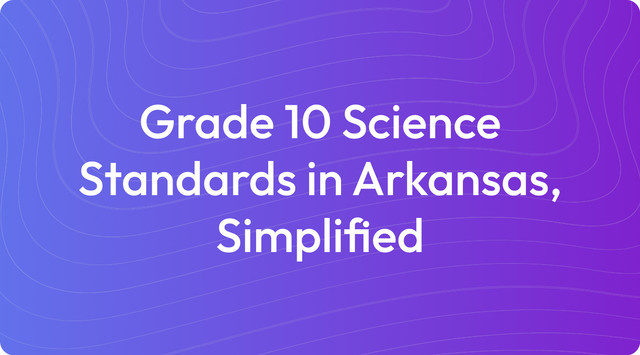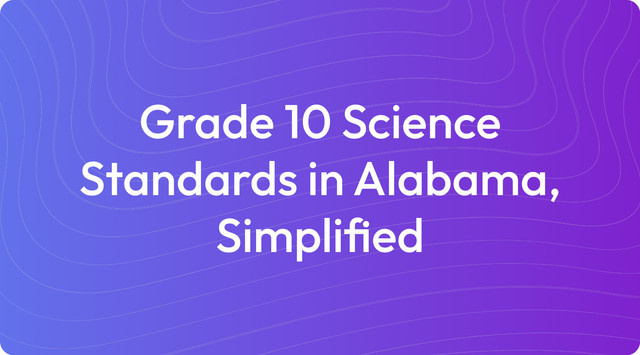Grade 5 Science Standards in California, Simplified
Grade 5 science in California: matter, cycles, and ecosystems made simple. Check the standards—read more on TeachShare!
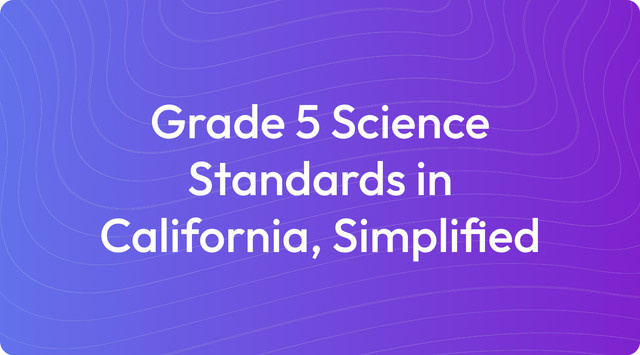
We understand that state standards form the foundation of your curriculum planning. These guidelines define learning progressions for students, but translating them into effective classroom activities can be a significant task. Our aim is to offer clear resources and support that help you connect these requirements directly to your instruction.
Education standards are essentially learning goals that outline what students are expected to know and do at each grade level. For teachers, they provide a clear framework for instruction without dictating specific teaching methods. For instance, California's fifth-grade science standards require students to develop a model showing that matter is made of particles, which guides instruction toward hands-on activities and conceptual understanding rather than just memorization.
What Are Grade 5 Science Standards in California?
The California Next Generation Science Standards (CA NGSS) for fifth grade are built around four core scientific domains to help students build a cohesive understanding of science. Here is an overview of the key focus areas and concepts you will cover:
1. Physical Science (PS): Matter and Energy
PS1: Matter and Its Interactions
- Key Standard (5-PS1-1): Develop a model to describe that matter is made of particles too small to be seen.
- Key Standard (5-PS1-2): Measure and graph properties of matter (e.g., weight, volume) to identify materials.
- Key Standard (5-PS1-3): Observe and conduct investigations to determine if mixing substances results in new substances (chemical changes).
PS3: Energy
- Key Standard (5-PS3-1): Use models to describe how plants use energy from sunlight to produce food (photosynthesis).
2. Life Science (LS): Matter and Energy in Ecosystems
LS1: From Molecules to Organisms
- Key Standard (5-LS1-1): Support an argument that plants get the materials they need for growth from air and water.
LS2: Ecosystems: Interactions, Energy, and Dynamics
- Key Standard (5-LS2-1): Develop a model to describe how matter and energy flow through ecosystems (e.g., food webs).
3. Earth and Space Science (ESS): Systems and Cycles
ESS2: Earth’s Systems
- Key Standard (5-ESS2-1): Develop a model to describe interactions between Earth’s systems (geosphere, biosphere, hydrosphere, atmosphere).
- Key Standard (5-ESS2-2): Analyze and interpret data to show how water is distributed on Earth (oceans, rivers, glaciers).
ESS3: Earth and Human Activity
- Key Standard (5-ESS3-1): Obtain and combine information about how communities protect Earth’s resources and the environment.
4. Engineering, Technology, and Applications of Science (ETS): Problem Solving
ETS1: Engineering Design
- Key Standard (3-5-ETS1-1): Define a problem that can be solved through engineering, including criteria for success and constraints.
- Key Standard (3-5-ETS1-3): Test and improve solutions based on evidence (e.g., designing a water filtration system).
Key Crosscutting Concepts (CCCs) for Grade 5 Science
- Energy and Matter: Understanding how energy and matter move through systems (e.g., food webs, water cycle)
- Systems and Models: Exploring how parts of Earth’s systems interact (e.g., atmosphere and hydrosphere)
- Cause and Effect: Observing how changes in one part of a system affect others (e.g., human activities on ecosystems)
The framework for these standards is guided by the Next Generation Science Standards and resources from the California Department of Education.
Key Tested Standards
The Grade 5 Science Standards in California, based on the CA NGSS, emphasize foundational concepts assessed through hands-on investigations, modeling, and evidence-based explanations. To help you focus your instruction, we have highlighted the key standards that are likely to be emphasized on assessments. Here are the key tested standards:
1. Physical Science (PS): Matter and Energy
- 5-PS1-1: Matter is Made of Particles
Develop a model to describe that matter is made of particles too small to be seen. - 5-PS1-2: Properties of Matter
Measure and graph properties of different materials to identify substances. - 5-PS1-3: Mixing Substances
Conduct investigations to determine whether mixing substances results in new substances. - 5-PS3-1: Energy from the Sun
Use models to explain how plants use energy from sunlight to make food through photosynthesis.
2. Life Science (LS): Matter and Energy in Ecosystems
- 5-LS1-1: Plant Growth
Support an argument that plants get the materials they need for growth from water and air. - 5-LS2-1: Matter and Energy in Ecosystems
Develop a model to describe how matter cycles and energy flows in ecosystems.
3. Earth and Space Science (ESS): Earth's Systems and Resources
- 5-ESS2-1: Earth’s Systems Interactions
Develop a model to describe how Earth’s systems interact, including the geosphere, biosphere, hydrosphere, and atmosphere. - 5-ESS2-2: Water Distribution on Earth
Analyze and interpret data to show how water is distributed across Earth’s surface. - 5-ESS3-1: Protecting Earth’s Resources
Obtain and combine information about how human communities use resources and protect the environment.
4. Engineering, Technology, and Applications of Science (ETS): Problem-Solving
- 3-5-ETS1-1: Define a Problem
Define a design problem that can be solved through engineering, including criteria for success and constraints. - 3-5-ETS1-3: Optimize Solutions
Test and improve designs based on evidence.
The information and standards listed above are based on guidelines from the following educational authorities:
Example Learning Objectives for Unit Planning
Learning objectives translate broad standards into clear, measurable goals for your students. They act as a roadmap for your lessons, defining what students should be able to do by the end of a unit. These student-friendly "I can" statements also help learners track their own progress and understand the purpose of each activity.
Here are examples of learning objectives for two Grade 5 Science standards in California. These objectives are written in student-friendly language and aligned to the NGSS three-dimensional learning approach:
Standard: 5-PS1-3
This standard focuses on having students conduct investigations to determine whether mixing substances results in new substances.
Learning Objectives:
- I can conduct experiments to observe what happens when I mix two substances (e.g., baking soda and vinegar).
- I can describe the difference between physical changes (e.g., mixing sand and water) and chemical changes (e.g., creating gas bubbles).
- I can identify evidence of a chemical change, like changes in color, temperature, or the formation of a new substance.
- I can record my observations and use them to explain whether mixing substances created a new material.
Standard: 5-LS2-1
This standard requires students to develop a model that describes how matter and energy move through ecosystems.
Learning Objectives:
- I can explain how energy from the Sun moves through an ecosystem using a food chain or food web.
- I can create a model (e.g., drawing or diagram) to show how plants, animals, and decomposers transfer energy and matter.
- I can describe the roles of producers, consumers, and decomposers in an ecosystem.
- I can use my model to explain how energy flows and matter cycles in an ecosystem.
Key Changes & Updates
The Grade 5 Science Standards saw a significant update with the adoption of the California Next Generation Science Standards (CA NGSS) in 2013. This change represented a new direction for science education, moving the focus from memorization to active inquiry. The core of this update is “three-dimensional learning,” an approach that weaves together Science and Engineering Practices (what students do), Disciplinary Core Ideas (what students know), and Crosscutting Concepts (how students think across scientific domains). For your classroom, this means guiding students to ask questions, conduct investigations, and build understanding through direct experience.
Another key change is the integration of engineering design, which encourages students to apply scientific principles to solve practical problems. The standards are also built around real-world phenomena, making lessons more relevant and engaging for students. Instead of just learning facts, students are now expected to analyze data, construct models, and use evidence to support their explanations. This method helps develop critical thinking and prepares students for more advanced scientific study by focusing on how to think and act like scientists and engineers.
Create with TeachShare
We know that turning these standards into engaging, effective lessons takes time you don't always have. Our platform is designed to help you build high-quality, standards-aligned activities and assessments quickly, so you can focus more on teaching and less on prep work. Start creating standards-aligned instructional resources with TeachShare now.
Frequently Asked Questions
1. What are the main topics covered in Grade 5 Science?
Fifth-grade science in California is built around four key areas of study. Here’s a look at what students will explore:
- Physical Science: Students learn about the properties of matter, what happens during physical and chemical changes, and how energy is transferred in systems like photosynthesis.
- Life Science: This area focuses on how matter and energy move through ecosystems in food chains and food webs, and how plants use basic resources like air and water to grow.
- Earth and Space Science: Students investigate the interactions between Earth’s major systems (geosphere, hydrosphere, biosphere, and atmosphere), the water cycle, and the impact of human activity on the planet.
- Engineering: A practical component where students apply scientific principles to design and test solutions for real-world challenges, such as creating a water filtration system.
2. What makes the NGSS different from previous science standards?
The Next Generation Science Standards (NGSS) change the approach to science education by focusing on a few core shifts. The main differences include:
- Three-Dimensional Learning: This approach combines science practices, crosscutting concepts, and core ideas, moving away from simple memorization.
- Hands-On Learning: Students are encouraged to actively investigate scientific concepts through experiments, modeling, and direct observation.
- Real-World Applications: Lessons are connected to phenomena that students can see in their own lives, making the material more relevant and engaging.
- Engineering Integration: Students don't just learn science; they use it to design and test solutions to authentic problems.
3. What are some examples of activities aligned with Grade 5 standards?
To bring the standards to life, you can use a variety of hands-on activities in the classroom. Here are a few examples:
- Modeling Matter: Students can develop a model to show that matter is made of particles too small to be seen, such as by illustrating air particles inside a balloon.
- Observing Chemical Changes: A classic experiment where students mix substances like baking soda and vinegar to observe the formation of a gas, which is evidence of a chemical reaction.
- Creating Ecosystem Models: Students can draw food web diagrams to demonstrate how energy flows from producers to consumers and decomposers within an ecosystem.
- Building a Water Cycle Model: Students can construct a small, enclosed model to show how water evaporates, condenses, and precipitates.
- Solving Environmental Problems: Students can research a local issue, like water conservation, and develop a practical plan to help address it.
4. How do these standards connect to real-world applications?
A primary goal of the standards is to help students see the connection between science and their everyday experiences. For instance, they learn about:
- How the principles of matter and chemical changes apply to daily activities like cooking and cleaning.
- Why biodiversity is important by studying how energy moves through local and global ecosystems.
- The direct impact of human activities on Earth’s systems, such as pollution and resource use, and what can be done to protect the environment.
5. How are students assessed in Grade 5 Science?
Assessment under the NGSS is more about demonstrating understanding than just taking a test. Students are typically evaluated through:
- Hands-On Investigations: Teachers can observe students as they conduct experiments, noting their process and conclusions.
- Models: Students can be asked to create and explain models of concepts like particle interactions, food webs, or Earth’s systems.
- Data Analysis: You can assess how students graph and interpret data from their investigations, such as water distribution on Earth.
- Evidence-Based Explanations: Students are expected to write or present their findings, using evidence gathered from their activities to support their claims.
Answer



